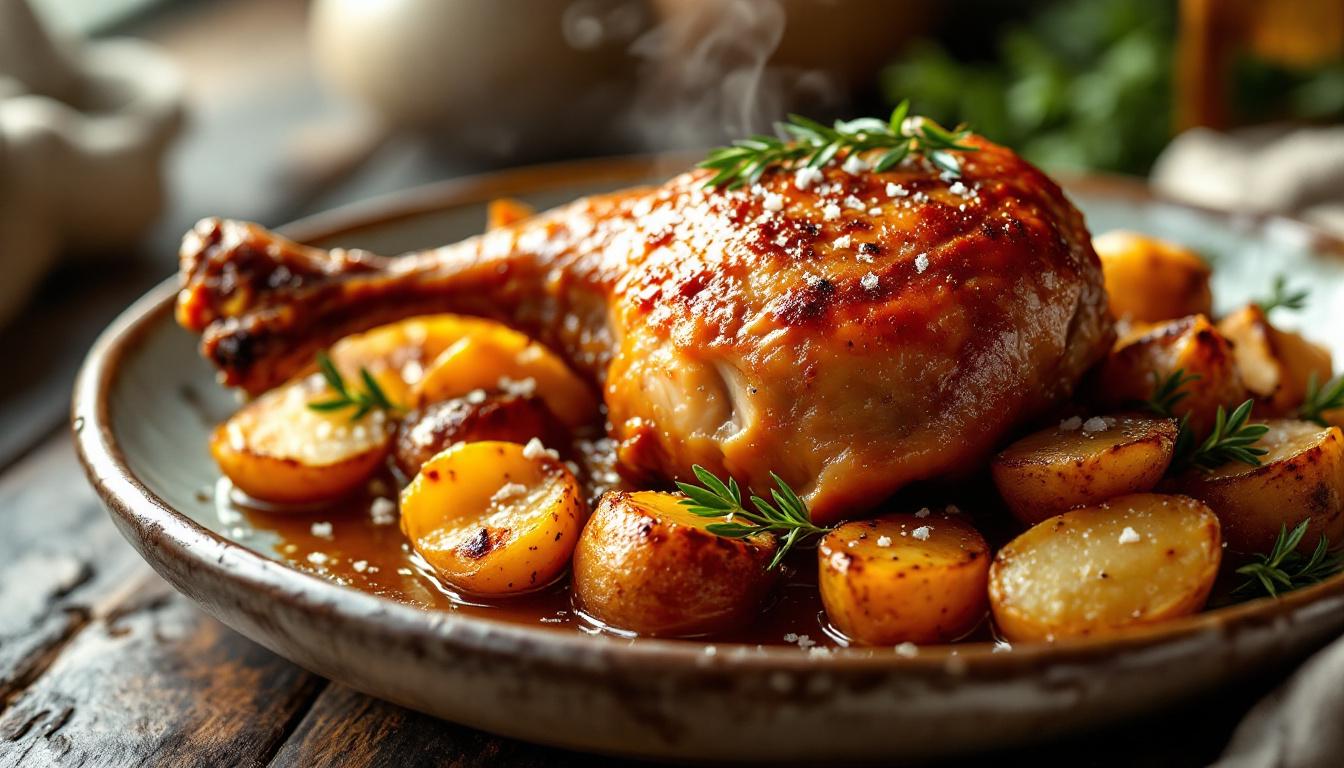The first time I encountered duck confit in southwestern France, I was mesmerized by its contradictions. Here was a preservation technique centuries old, yet yielding something so luxurious it defied its humble origins. What truly stunned me was how the Gascons transformed this preserved meat into a complete experience by pairing it with potatoes cooked in the same golden fat. The crackling skin against the fork-tender meat, combined with those crispy-edged, creamy-centered potatoes—it was an epiphany that forever changed how I approach seemingly simple ingredients.
The Story
Confit de canard began as rural preservation method in Gascony where duck legs were salt-cured then slowly poached in their own fat—creating a seal that preserved meat for months before refrigeration existed. What started as necessity evolved into culinary brilliance, with those same preserved legs being crisped to perfection before serving. The accompanying pommes sarladaises (potatoes cooked in duck fat) emerged from the neighboring Périgord region, creating a perfect marriage of technique and flavor.
What makes this pairing magical isn’t complicated technique but patience and respect for ingredients. The alchemy happens when time transforms basic components into something transcendent.
Ingredients Spotlight
For the duck confit (serves 4):
- 4 duck legs (about 8-10 oz/225-280g each)
- 3 tablespoons (45g) coarse sea salt
- 4 garlic cloves, lightly crushed
- 4 sprigs fresh thyme
- 2 bay leaves
- 4-5 cups (1-1.2L) duck fat (enough to fully submerge legs)
For the pommes sarladaises:
- 2 pounds (900g) waxy potatoes like Yukon Gold, peeled
- 4 tablespoons (60ml) reserved duck fat
- 3 garlic cloves, thinly sliced
- 2 tablespoons fresh parsley, chopped
- Sea salt and freshly ground pepper to taste
Step-by-Step Guide
For the confit:
- Rub duck legs thoroughly with salt, then arrange in a single layer in a dish with garlic, thyme and bay leaves. Cover and refrigerate for 24 hours.
- Rinse legs under cold water to remove excess salt and pat completely dry with paper towels.
- Preheat oven to 225°F (110°C). Place legs in a heavy, oven-safe pot and completely cover with melted duck fat.
- Cook uncovered for 3-4 hours until meat easily pulls away from the bone when tested with a fork.
- Let cool in the fat for 30 minutes, then transfer legs to a storage container and strain the fat over them, making sure they’re completely covered. Refrigerate for at least 24 hours (or up to 1 month).
For the pommes sarladaises and serving:
- Slice potatoes into 1/4-inch (6mm) rounds.
- Heat 4 tablespoons reserved duck fat in a large skillet over medium heat.
- Add sliced garlic and cook for 30 seconds until fragrant.
- Add potato slices in a single layer (work in batches if needed) and cook for 15-20 minutes, turning occasionally, until golden and tender.
- While potatoes cook, preheat oven to 400°F (200°C).
- Remove duck legs from fat, place skin-side up in a roasting pan, and roast for 20-25 minutes until skin is deeply bronzed and crackling.
- Season potatoes with salt and pepper, sprinkle with parsley, and serve alongside the crispy duck legs.
Expert Techniques
The secret to exceptional confit lies in temperature control. Keep the fat between 190-200°F (88-93°C) during cooking—hot enough to tenderize but never so hot it bubbles vigorously. This gentle poaching preserves the meat’s integrity while allowing it to absorb the fat’s flavor.
Chef’s Note: Don’t discard the used duck fat! Strain it, refrigerate it, and use it for roasting vegetables, frying eggs, or making the world’s best hash browns. In my kitchen, this liquid gold gets recycled endlessly—each use adding another layer of flavor complexity.
For perfect pommes sarladaises, the key is patience. Resist the urge to stir constantly; let the potatoes develop a golden crust before turning. And never cover them—you want evaporation, not steaming.
Presentation & Pairing Ideas
Serve this rustic masterpiece on warmed plates with the duck leg perched atop a generous portion of the golden potatoes. A small pile of frisée or bitter greens dressed with a sharp mustard vinaigrette provides the perfect acidic counterpoint to cut through the richness.
Wine pairing is crucial here—look for something with enough structure to stand up to the dish’s richness. A Madiran from the same region works beautifully, as does a Languedoc Syrah blend. For a white option, try an off-dry Jurançon that will complement rather than surrender to the intensity.
For a seasonal variation, in autumn, scatter some wild mushrooms among the potatoes during the last five minutes of cooking. In spring, serve with a side of young green beans quickly blanched and tossed with garlic and lemon zest.
Remember, this dish teaches us that greatness often comes from patience rather than complexity. Make it on a weekend when you can move unhurriedly through each step, absorbing the aromas and transformations. The techniques you’ll master here—gentle poaching, fat preservation, proper crisping—will serve you across countless other dishes in your culinary journey. 🦆✨
